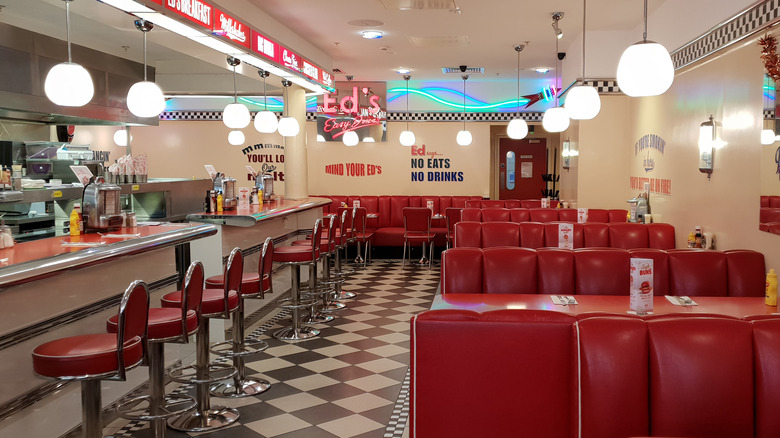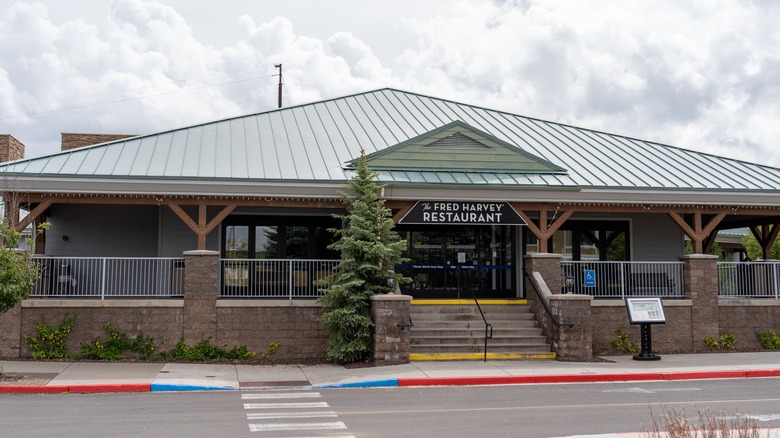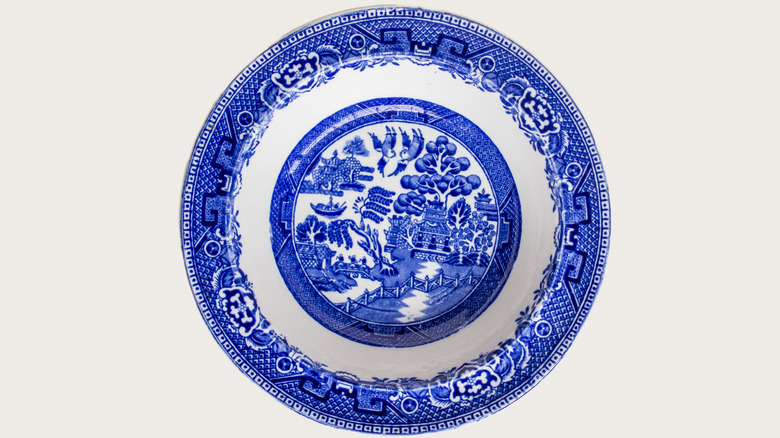What's The Origin Of The Phrase 'Blue Plate Special'?
Diners are as American as the apple pies they serve. The streamlined silver building, bright neon sign, counter stools, vinyl booths, and hit-or-miss coffee are steeped in nostalgia. Even before Guy Fieri's "Diners, Drive-Ins, and Dives," diners have been a central piece of American culture.
In fact, this is probably a big reason why swinging through a diner is the traditional way for presidential candidates to show their credentials as real Americans. Eater even calls New Hampshire's Red Arrow Diner a "must-visit" place if you want to win the state's critical primary. Fail to do so, and you're basically voting against yourself. If you want the American people to trust you with nuclear codes, we've got to see you slamming a milkshake at a Formica counter first. That's just the way it is.
Even if you've never been to a diner, you know them as the backdrop to famous scenes in "Pulp Fiction," "Grease," "Back to the Future," and a long, long list of others (via Vogue). Some of these depictions have introduced bits of diner lingo to the masses. Maybe you've heard terms like "heart attack on a rack," meaning biscuits and gravy, or "86," meaning remove something from the menu (via MentalFloss). Perhaps the most enduring is the "blue plate special."
Per CulinaryLore, this is a large meal (typically meat, three to four sides, bread, and a drink) offered at a low price. The thing is, it rarely comes on a blue plate. Why then do we call it that? As with most diner lingo, there's some uncertainty here, but two theories prevail.
Theory number one: the Fred Harvey story
Many sources trace the term "blue plate special" to Fred Harvey, a British-born entrepreneur who started America's first restaurant chain back in the 1870s (via Deseret News). Strategically located along the Atchison, Topeka and Santa Fe Railway, which was the nation's largest railroad at the time, Harvey found great success catering to travelers. Though primarily based in small Southwestern cities, Harvey imported ingredients from metropolises like New York and Chicago by way of refrigerated train cars. These fresh, high-quality offerings set him apart from any competition in the area. According to The Kansas Historical Society, by the time Harvey died in 1901, he owned 45 restaurants and 20 dining cars across 12 states.
Harvey's family kept expanding the business, starting the Fred Harvey Company. Deseret News notes that much of the famous Route 66 was built parallel to the Atchison, Topeka, and Santa Fe Railway, bringing road traffic to the restaurants even as rail travel declined. Anyone passing through the Southwest in those days was almost certain to run across one, and if they chose to stop for a meal, they would surely discover the blue plate special. According to CulinaryLore, Harvey's restaurants were credited with introducing the term "blue plate special" in 1892. As the story goes, they used disposable plates with divided sections for the main course and sides, and they just so happened to be blue. It's a nifty story, but is it true?
Theory number two: the blue willows
So, we've heard the theory of the disposable plate; now for a complete 180. According to CulinaryLore, other evidence suggests that the original blue plates were actually made from white china, decorated with an ornate blue pattern known as the "blue willow" motif. Each set of plates can vary, but they all have common symbols: willow trees, a pagoda, a fence, two birds, and three people crossing a bridge. These supposedly relate to a Chinese legend of two lovers forbidden to see each other. The three figures on the bridge are the lovers being chased by the girl's father. Ultimately, they die and are reborn as birds. However, The Vermont Country Store reveals that the tale does not align with Chinese mythology and was likely made up for marketing. Despite the Chinese aesthetic, these plates actually originated in England.
Pet CulinaryLore, most china companies in the early 1900s made some rendition of the blue willow plate. While ornate china seems luxurious on the surface, these plates were extremely common at the time, and typically cost very little. They were so cheap in fact, that you could find them in diners all over the country, even at the height of the Great Depression. One popular style of the plate had separate sections for mains and sides. Which blue plate theory is true? No one can say for certain, but at least we still have our big ol' milkshakes and the perfect spot for a campaign photo-op.


